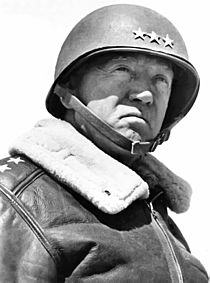Three-star rank facts for kids
A three-star rank is a very high position in many armed forces around the world. These officers are senior commanders. They hold a rank that NATO (North Atlantic Treaty Organization) calls "OF-8." This term is also used by countries not in NATO.
Typically, three-star officers have ranks like vice admiral (for navies), lieutenant general (for armies), or air marshal (for air forces). These ranks show they are in charge of many soldiers, ships, or aircraft.
Contents
Australia
In the Australian Defence Force, these officers hold three-star ranks:
- Vice admiral for the Royal Australian Navy.
- Lieutenant general for the Australian Army.
- Air marshal for the Royal Australian Air Force.
Australian three-star officers do not use stars on their official badges like the United States does. However, they sometimes wear star badges when working with other countries' militaries. This helps everyone recognize their rank easily.
The leaders of all three Australian military services have a three-star rank. Also, four other important joint positions are three-star ranks. These include the Vice Chief of Defence Force.
Bangladesh
In Bangladesh, the three-star ranks are:
- Lieutenant general in the Bangladesh Army.
- Vice admiral in the Bangladesh Navy.
- Air marshal in the Bangladesh Air Force.
Canada
In Canada, the three-star equivalent ranks are:
- Vice admiral for the Royal Canadian Navy.
- Lieutenant-general for the Canadian Army and Royal Canadian Air Force.
Their rank badges show three maple leaves with a crown. They also have a crossed sabre and baton. Before the Canadian forces were unified, the air marshal rank was the three-star equivalent for the RCAF.
Germany
The German military, called the Bundeswehr, has these three-star ranks (OF-8):
- Generalleutnant and Vizeadmiral.
- Generaloberstabsarzt and Admiraloberstabsarzt.
It's important not to confuse these with older ranks from before 1990.
India
India's armed forces have these three-star ranks:
- Air marshal in the Indian Air Force.
- Lieutenant general in the Indian Army.
- Vice admiral in the Indian Navy.
Indonesia
Indonesia's military uses these three-star ranks:
- Letnan Jenderal (lieutenant-general) for the Indonesian Army and Indonesian Marine Corps.
- Laksamana Madya (vice admiral) for the Indonesian Navy and Indonesian Maritime Security Agency.
- Marsekal Madya (vice air marshal) for the Indonesian Air Force.
Pakistan
Pakistan's military has these three-star ranks:
- Lieutenant-general in the Pakistan Army.
- Air-marshal in the Pakistan Air Force.
- Vice admiral in the Pakistan Navy.
Philippines
In the Philippines, the three-star ranks are:
- Lieutenant general in the Philippine Army.
- Lieutenant general in the Philippine Air Force.
- Vice admiral in the Philippine Navy.
- Vice admiral in the Philippine Coast Guard.
United Kingdom
The United Kingdom's armed forces use these three-star ranks:
- Vice admiral in the Royal Navy.
- Lieutenant general in the British Army and Royal Marines.
- Air marshal in the Royal Air Force.
-
Lieutenant-General John Cooper wearing both three-star insignia and lieutenant general insignia
United States
In the United States, three-star ranks include:
- Vice admiral for the United States Navy, Coast Guard, and other uniformed services.
- Lieutenant general for the United States Army, Marine Corps, Air Force, and Space Force.
A vice admiral often commands a large group of naval ships. An Army or Marine Corps lieutenant general usually leads a unit of 20,000 to 45,000 soldiers. An Air Force lieutenant general commands a big air force group with many wings. These high-ranking officers also work in important leadership roles at major military headquarters.
Russia and the USSR
In the armies of Russia and the former Soviet Union, the three-star rank is called colonel-general (Russian: генерал-полковник). For the navy, it is full admiral (Russian: адмирал). These ranks first appeared in 1940. Many countries that were allied with the Soviet Union also adopted these ranks.
Colonel-generals often command ground forces, lead military academies, or head military districts. This rank is a step towards becoming a "general of the army" or even a "marshal of the Russian Federation." This title also applies to three-star officers in the air force, police, and other security services.
Ukraine
Armed Forces of Ukraine
In Ukraine, a colonel general became a three-star general on June 16, 1920. After 1921, the UPR stopped existing due to the Red Army occupation.
When Ukraine became independent again in 1991, its armed forces kept the Soviet-style ranks and badges. So, a colonel general (Ukrainian: Генерал-полковник) and an admiral (Ukrainian: Адмірал) wore three stars on their shoulder straps.
On July 5, 2016, Ukraine's President approved a plan to change military ranks. This plan would make lieutenant general and vice admiral the three-star ranks.
On November 20, 2017, new rules were set. Colonels and admirals still wore three stars, but the stars changed from five points to four points.











